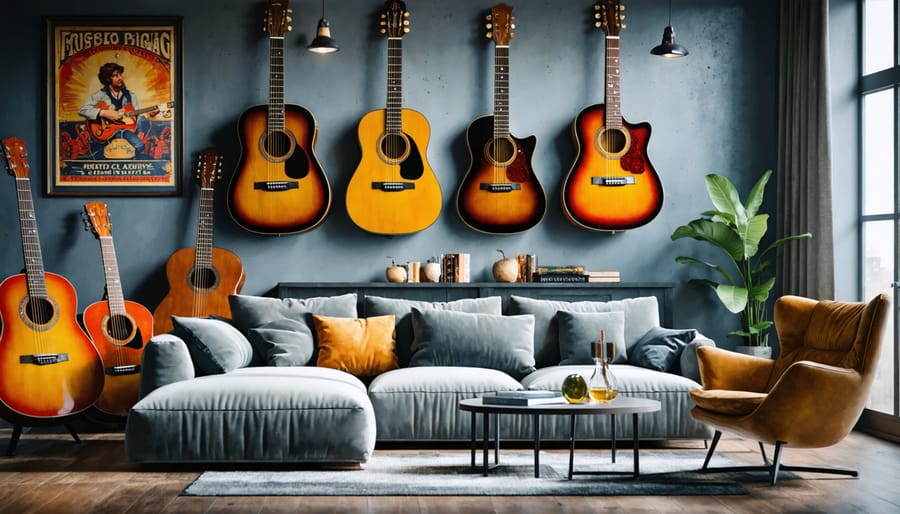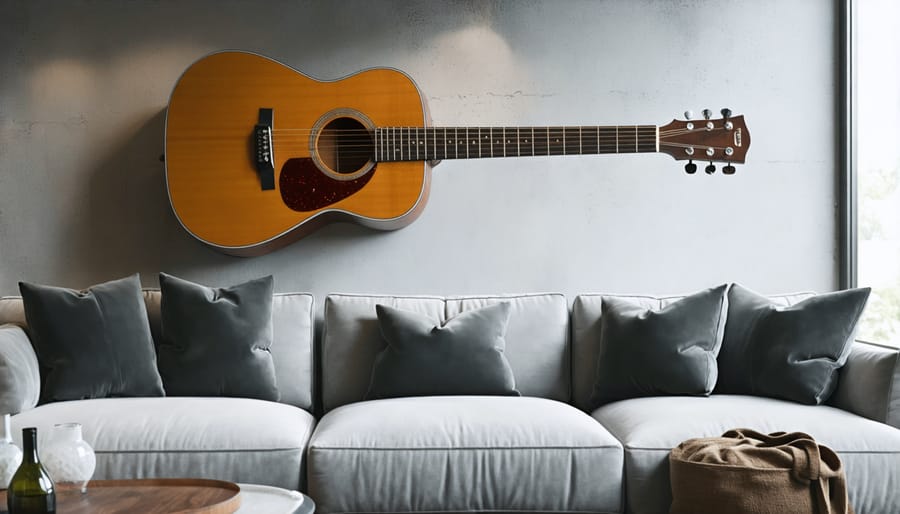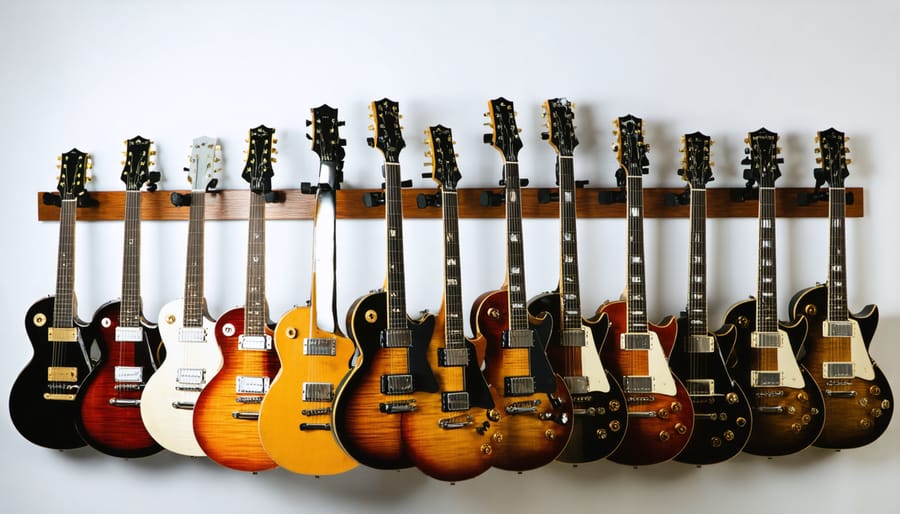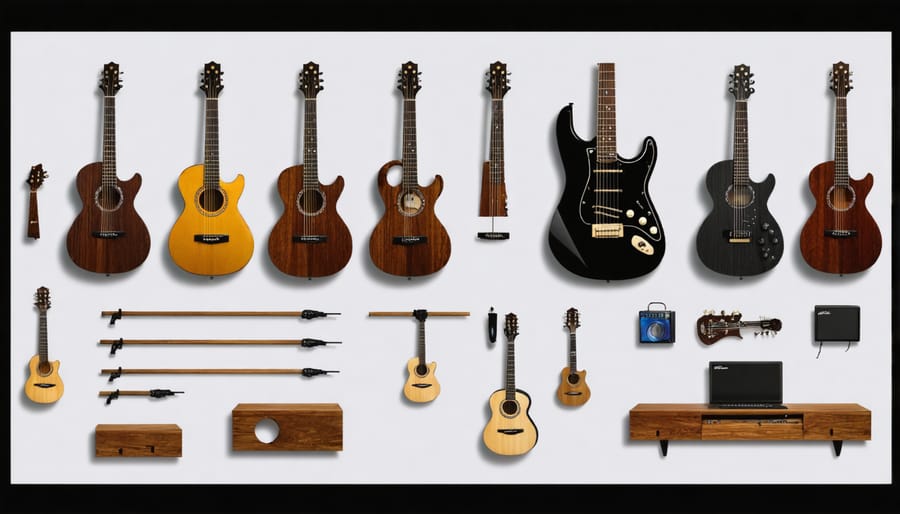
Transform Your Room’s Sound with These Smart Acoustic Guitar Design Elements
Transform your living space into a musician’s sanctuary by artfully displaying acoustic guitars as functional decor pieces. The timeless beauty of wooden instruments adds warmth and character to any room, while proper mounting and positioning ensure your guitars remain playable and protected. Whether you’re a performing artist or collector, integrating acoustic guitars into your interior design creates a sophisticated focal point that celebrates both music and aesthetics.
Strategic placement near temperature-controlled areas, away from direct sunlight and heating vents, maintains instrument integrity while showcasing their natural beauty. Modern mounting solutions, from handcrafted wooden wall brackets to museum-quality display cases, offer secure storage without compromising your home’s design aesthetic. Consider creating a dedicated music corner where guitars become part of a larger artistic arrangement, complemented by vintage concert posters, ambient lighting, and comfortable seating.
The key lies in balancing visual appeal with instrument care – your guitars should be easily accessible for playing while serving as striking design elements that reflect your passion for music. This approach to musical instrument display transforms everyday storage into an intentional design choice that enhances your home’s character.
Beyond Wall Art: The Musical Appeal of Acoustic Guitars in Home Design
Selecting the Perfect Guitar for Your Space
When selecting a guitar to display in your space, consider both the instrument’s visual impact and how it harmonizes with your existing decor. Dreadnought guitars, with their bold, traditional silhouettes, make striking statements in rustic or traditional rooms, while parlor guitars offer a more delicate presence perfect for smaller spaces or minimalist designs.
Color matching is crucial – choose between natural wood finishes that complement your furniture or bold sunbursts that can serve as artistic focal points. For modern interiors, consider guitars with lighter tonewoods like maple or spruce, while darker woods like mahogany and rosewood blend beautifully with classic or vintage-inspired spaces.
Size matters too – a concert-sized guitar might be ideal for an apartment wall, while a grand auditorium could command attention in a larger living room. Pay attention to the guitar’s hardware finish; nickel and chrome hardware suits contemporary spaces, while aged brass adds character to vintage-themed rooms.
Remember that the guitar’s placement should allow for easy access if you plan to play it, ensuring both form and function in your design scheme.
Strategic Placement for Visual Impact
Strategic placement of acoustic guitars can transform them from mere instruments into stunning design elements. Consider mounting your guitar on a feature wall where natural light hits during peak hours, creating an eye-catching interplay of shadows and highlights. Complement this with smart lighting design to enhance the guitar’s natural curves and wood grain patterns throughout the day.
For maximum visual impact, position guitars at eye level in social spaces like living rooms or entertainment areas. Create a focal point by arranging a single guitar above a fireplace or centering it between windows. For multiple guitars, try a asymmetrical arrangement that follows a gentle curve or diagonal line, maintaining enough space between each instrument to let them “breathe” visually.
In home studios or music rooms, consider grouping guitars by style or wood tone to create an organized display that’s both functional and aesthetically pleasing. Remember to keep instruments away from direct sunlight and heating vents to protect their finish while maintaining their decorative appeal.

Sound-Enhancing Display Solutions
Wall-Mounting Systems That Protect Your Instrument
Properly displaying your acoustic guitar requires a reliable wall-mounting system that both showcases and protects your instrument. When choosing a mount, consider options that complement your modern wall coverings while providing secure support for your guitar.
The most popular mounting systems include traditional wooden hangers, padded bracket systems, and designer display mounts. Wooden hangers offer classic appeal and typically feature foam or felt padding to protect the guitar’s finish. Bracket systems provide adjustable support points and often include protective rubber coating on all contact surfaces.
For installation, always locate wall studs using a stud finder – never rely solely on drywall anchors for mounting musical instruments. Position the mount at eye level, approximately 60-65 inches from the floor, ensuring easy access while creating visual appeal. Leave at least 4 inches of clearance between the wall and the guitar’s body to prevent contact damage.
Consider humidity-controlled display cases for valuable instruments in areas with significant temperature fluctuations. These systems integrate seamlessly with your decor while maintaining optimal conditions for your guitar. For added security, many premium mounts include locking mechanisms that prevent accidental dislodging while still allowing quick access for playing.
Remember to check the weight rating of your chosen mount and ensure it exceeds your guitar’s weight by at least 50% for safety.
Floor Stands and Display Cases
Floor stands and display cases offer elegant solutions for showcasing your acoustic guitar while keeping it easily accessible and protected. A quality floor stand brings your instrument into the living space as a intentional design element, rather than simply leaning it against a wall or hiding it away in a case.
Premium wooden floor stands complement your guitar’s natural beauty and can match your existing furniture. Look for stands with plush padding at contact points to protect your instrument’s finish. Many modern stands feature adjustable heights and angles, allowing you to create the perfect visual presentation while maintaining stability.
Display cases take protection a step further while maximizing visual impact. Glass-enclosed cases with proper humidity control provide museum-quality presentation while safeguarding your guitar from dust, accidental bumps, and environmental fluctuations. LED lighting options can dramatically enhance the display, creating an artistic focal point in any room.
For the ultimate statement piece, consider custom-built display solutions that incorporate multiple guitars. Wall-to-ceiling cases or freestanding towers can showcase an entire collection while adding architectural interest to your space. Many premium display cases include UV-protective glass and built-in humidity monitoring systems, ensuring your instruments remain in pristine condition while on display.
Remember to position floor stands and cases away from direct sunlight and high-traffic areas to prevent accidents and protect your guitar from harmful UV rays.

Creating a Guitar-Friendly Environment
Temperature and Humidity Control
Maintaining proper temperature and humidity levels is crucial for preserving your acoustic guitar while creating an environment that can improve your home’s wellbeing. The ideal room temperature should stay between 68-72°F (20-22°C), with relative humidity between 45-55%. Sudden changes in these conditions can cause wood to expand or contract, potentially damaging your instrument.
Consider installing a smart thermostat and humidity monitor in rooms where guitars are displayed. These devices can alert you when conditions drift outside optimal ranges. A small room humidifier or dehumidifier can help maintain stable moisture levels, especially during extreme seasons.
For added protection, use humidity control packets in guitar cases when instruments aren’t on display. If you’re mounting guitars in rooms with large windows, consider UV-filtering window films to prevent sun damage. Position instruments away from heating vents, air conditioners, and exterior walls where temperature fluctuations are most dramatic.
Remember that consistent conditions are just as important as the actual temperature and humidity levels. Gradual seasonal changes are less problematic than daily swings, so focus on creating a stable environment year-round.
Lighting Considerations
Proper lighting is crucial when displaying acoustic guitars, serving both aesthetic and preservation purposes. LED strips or small spotlights can create dramatic shadows that highlight the guitar’s natural curves and wood grain. However, avoid placing guitars in direct sunlight or under harsh fluorescent lighting, as UV rays can damage the finish and potentially warp the wood over time.
For optimal display lighting, consider using warm-white LED lights (2700K-3000K) that produce minimal heat. Position lights at a 45-degree angle to minimize glare on the guitar’s surface while creating depth and dimension. Track lighting offers flexibility for adjusting the focus as needed, while recessed lighting provides a clean, modern look without drawing attention away from the instrument.
If you’re creating a dedicated guitar display area, consider installing dimmer switches to control light intensity. This allows you to adjust the ambiance for different times of day or occasions. For added protection, use UV-filtered bulbs or special display cases with built-in lighting that includes UV protection. Remember to keep heat-generating lights at least 24 inches away from your instruments to prevent any potential damage from temperature fluctuations.
DIY Guitar Display Projects
Custom Wall Mount Creation
Creating a custom wall mount for your acoustic guitar combines functionality with artistic flair, and it’s a project you can complete in just a few hours. You’ll need a 1×6-inch piece of hardwood (cherry or walnut work beautifully), two rubber-coated guitar hooks, wall anchors, screws, wood stain or finish, and basic tools like a drill and sandpaper.
Start by cutting your hardwood to about 16 inches in length, which provides ample support for most acoustic guitars. Sand all surfaces thoroughly, progressing from medium to fine-grit sandpaper for a smooth finish. Round the edges slightly for a more refined look that complements your guitar’s curves.
Mark points for your guitar hooks approximately 12 inches apart, ensuring they’ll cradle your instrument securely. Pre-drill holes for the hooks, being careful not to split the wood. Install the rubber-coated hooks, which protect your guitar’s finish from scratches.
Apply your chosen wood stain or finish in thin, even coats. Allow each coat to dry completely before applying the next. Two to three coats typically provide excellent protection and a beautiful sheen. Once dry, attach keyhole hangers to the back of your mount for easy wall installation.
When mounting to the wall, use a level to mark your mounting points. Install wall anchors if you’re not hitting studs, as acoustic guitars typically weigh 4-5 pounds. Secure the mount to the wall, ensuring it’s completely level before hanging your guitar.
Add personal touches like carved initials, inlaid wood designs, or LED accent lighting to make your mount truly unique. Remember to position the mount away from direct sunlight and heating vents to protect your instrument.

Integrated Lighting Installation
Transform your guitar display into a captivating focal point by incorporating strategic lighting elements. Modern DIY lighting solutions make it easier than ever to highlight your acoustic guitars while creating an inviting atmosphere in your space.
LED strip lighting is particularly effective when installed behind wall-mounted guitars, creating a gentle halo effect that makes your instruments appear to float. Consider using warm white LEDs (2700K-3000K) to complement the natural wood tones of your acoustic guitars. These strips can be easily concealed within mounting brackets or along display shelving.
For cabinet displays, small puck lights installed at the top create dramatic shadows and emphasize the guitar’s curves. Battery-operated options eliminate the need for visible wiring, maintaining a clean aesthetic. Smart lighting systems allow you to control brightness and color temperature through your phone, perfect for adjusting the ambiance for different times of day.
Consider installing dimmer switches to control the intensity of your display lighting. This flexibility helps protect your instruments from excessive heat while allowing you to create the right mood for any occasion. For added drama, position small spotlights at the base of floor-standing displays, angling them upward to showcase the guitar’s craftsmanship.
Remember to avoid directing intense light directly onto the instrument’s surface, as this can potentially damage the finish over time. Instead, focus on creating subtle, indirect illumination that enhances rather than overwhelms. By thoughtfully integrating lighting into your guitar display, you’ll create an eye-catching feature that celebrates both the visual and musical aspects of these beautiful instruments.
Designing your space with acoustic guitars is more than just creating a beautiful display – it’s about harmoniously blending functionality with aesthetics. Throughout this guide, we’ve explored various ways to showcase your beloved instruments while protecting them and enhancing your room’s overall design.
Remember that proper mounting height, temperature control, and humidity management are crucial for maintaining your guitars’ condition. Whether you choose a classic wall mount, an illuminated display case, or a creative DIY solution, always prioritize instrument protection alongside visual appeal.
The versatility of acoustic guitars as decor elements means you can adapt these design principles to any room style, from rustic to modern. Consider incorporating complementary elements like vintage music sheets, LED lighting, or natural wood accents to create a cohesive theme that reflects your personal style.
Don’t be afraid to experiment with different arrangements and combinations. Your guitar display can evolve with your space, and the best designs often come from mixing practical solutions with creative vision. Whether you’re a musician looking to showcase your collection or a design enthusiast seeking unique decor elements, acoustic guitars can add both character and conversation pieces to your space.
By implementing these design strategies thoughtfully, you’ll create a space that not only looks stunning but also maintains the integrity of your instruments for years to come.
